As an Amazon Associate I earn from qualifying purchases.
I got an email from a reader a while back: “You should make a chile colorado recipe.” Well hell, I thought, that’s a great idea! Chile colorado, if you’ve never encountered it, is a pretty simple red chile sauce traditionally served over beef, venison or, less commonly, pork.
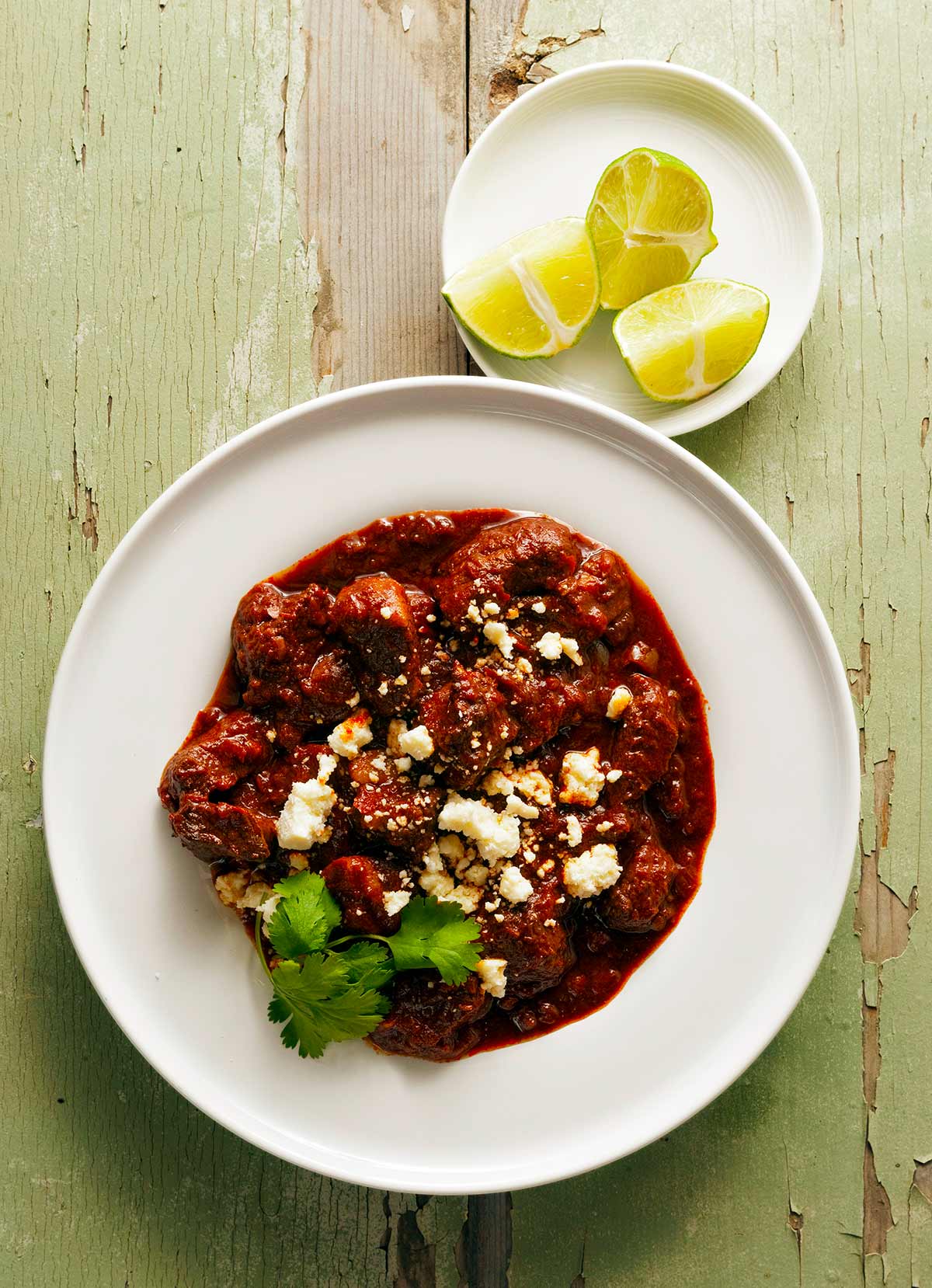
The origins of this sauce are unclear, but it seems to have come from the state of Chihuahua in Mexico, and has migrated up into New Mexico. There is a similar dish from Sonora called carne con chile, which I also like a lot.
“Colorado” here doesn’t refer to the state. Colorado in Spanish is, more or less, “colored red,” and is often used for blushing. I’ve also see it used specifically for the rich, dark reds of dried chiles.
For my chile colorado, dried, ripe New Mexican chiles are the most common pepper used to make it. Basically you soak dried chiles to soften them, grind them into a puree, season the sauce and simmer some tasty meat in it. Easy peasy.
Not so fast.
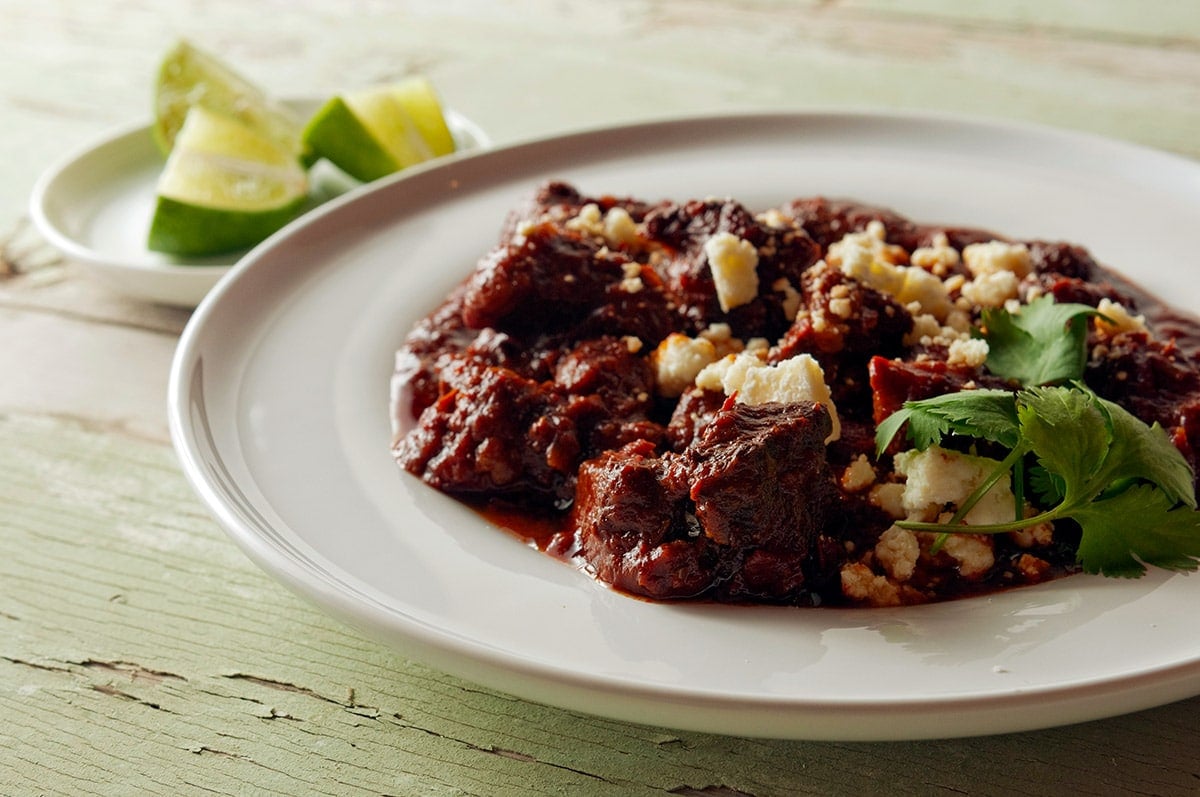
There is a step you need to take to make a great chile colorado: Strain out all the stray bits of chile skin. They do not puree well unless you have a badass blender. Poorly blended sauce will result in flakes getting stuck in your teeth, generally making a nuisance of themselves. And remember, pepper skins are not digestible.
Now you don’t have to strain the sauce, but it will be a lot better if you do.
Some people toast the dried chiles first. If you want to, go ahead. Just do it quickly, lest you burn the chiles, which makes them bitter. You want to see a little puffing up, not scorch marks. So do it over medium heat.
And you need not restrict your chile colorado sauce to this dish. It is a pretty good catch-all sauce, good for enchiladas, tamales, etc. I’ve had it with beef, pork and chicken at restaurants, so there is really no reason not to cook anything else in it: pheasant, turkey, bear, venison, duck — your imagination is your only limit.
And if you’d rather go green, the other big New Mexican stew is green chile stew, which, obviously, uses unripe, green chiles.
Chile Colorado
Ingredients
- 2 pounds beef, pork, venison, pheasant or turkey legs, etc.
- Salt
- 2 dried chipotle chiles (or chipotles in adobo)
- 4 dried ancho chiles
- 4 dried guajillo chiles
- 2 tablespoons lard or vegetable oil
- 2 cups chopped onion
- 5 garlic cloves, minced
- 1 quart of the appropriate stock, pork, beef, chicken, etc
- 1/2 cup crushed tomatoes
- 2 teaspoons cinnamon
- 1 tablespoon Mexican oregano
Instructions
- Cut the meat into large stewing pieces about 1 to 2 inches across. Salt well and set aside.
- Remove the stems and seeds from the dried chiles, tear them into pieces and put into a large bowl. Pour boiling water over them and cover. Let this stand until the chiles are rehydrated, about 30 minutes. Once the chiles are soft, put them in a blender with enough of the chile soaking water to make a puree the consistency of ketchup. If you want -- and I recommend this -- push the sauce through a fine-meshed strainer (into another bowl) to remove any stray seeds or bits of skin.
- In a heavy, lidded pot or Dutch oven, heat the lard over medium-high heat. Pat the meat dry with a paper towel and brown it well. Do this in batches and take your time. Remove the meat as it browns and set aside.
- Add the onions to the pot and cook them, stirring occasionally, until they just begin to brown on the edges. Add the garlic and cook another minute. Return the meat to the pot and mix in all the remaining ingredients. Bring to a gentle simmer and cook until the meat is tender.
- Serve with tortillas or over rice, garnished with queso seco, cilantro, maybe some raw onion, avocado and hot sauce.
Video
Notes
Nutrition
Nutrition information is automatically calculated, so should only be used as an approximation.
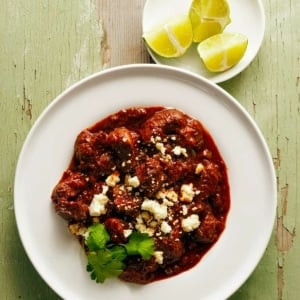
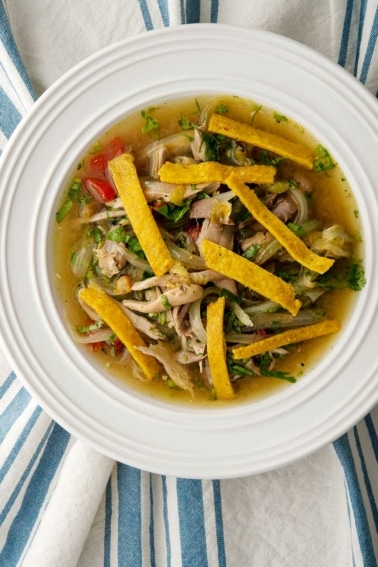
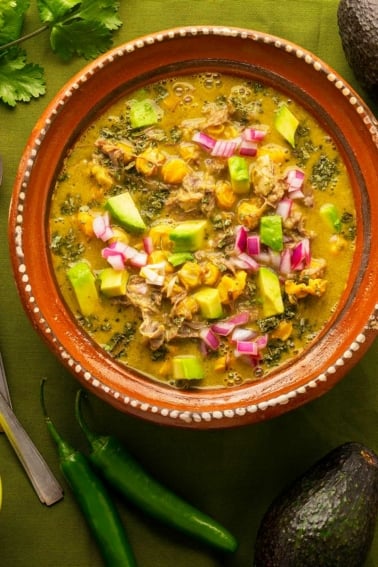
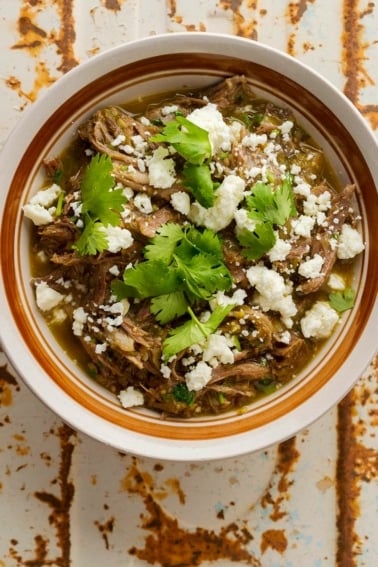
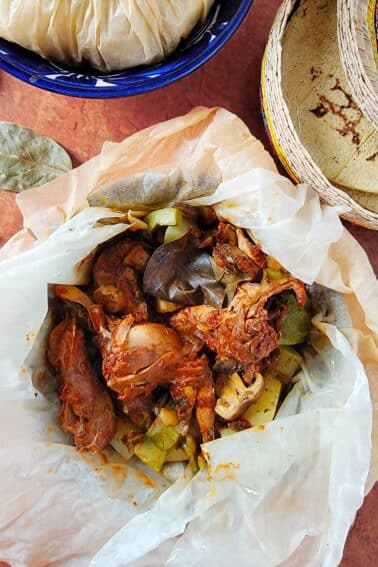
Is there a way to make a chili using venison shanks in Dutch oven. We have so many this year and don’t want to waste them. There is plenty of meat on them.
Or a green poblano tomatillo chili’s?
Hi Hank, excellent recipe as usual (the Mexican stuff always seems to knock it out of the park)! One thing I noticed is that my sauce turned to a darker red after the long braising time, and was a little thinner as I had to add some extra stock to get the liquid level at the right height for the meat. Since I was using this for tacos and wanted to keep that bright color and have a thicker sauce, this got me thinking if it would still work to braise the meat in another pot of liquid and assemble the sauce on the side to coat the meat with, much like your Mole Coloradito recipe – or is this one of those ones where I just shouldn’t mess with it?
Don: Absolutely. I do that a lot, actually. Either way works. You can also use only guajillos and/or “California” or New Mexico dried chiles, which are all much redder than anchos or pasillas.
Will a pro series vitamix 500 blend the chilies or do I still need to strain?
John: I use a Vitamix similar to that, and I rarely strain in this case. You should be good to go.
I made this with an older boar that had been eating a lot of coast live oak acorns, and it was fantastic! The traditional strong flavored sausages are great for a stronger flavored boar, but don’t turn the whole thing into sausage. Make sure to save some cuts to make this stuff!
Great recipe
This is a great way to use feral hog. The only addition I would make is to add some domestic pork shoulder for the fat content.
Ok Hank I am going to try several of these recipes they look great. The only reason I am writing is I am passionate about my chili. Do not go to CO, NM or WY and expect to have something that tasted like this served to you.
I haven’t tried the chili recipe so I shouldn’t be yakking. Seems to get great reviews too.
I have similar recipes that I make as we love chili. Never have I gotten one with cinnamon as an ingredient in chili, red, green or white! I lived in CO for 10 years and WY a number of years prior to that. Also made a number of trips to NM where it is generally just called red chili not CO chili. All those states have a lot of Chili Colorado.
Many times chili CO is green chili too (which you can’t find in TX east of Amarillo). My key point is I have never had chili with cinnamon in it. Not in CO, WY or NM, red or green, with or without meat. Many times the difference in NM and CO if you see Chili Colorado and red chili both on the menu is the Colorado version has meat and pork is very common.
I have never seen it with beans but you can probably find that in a few areas of CO because pintos used to be a huge crop and they use what they have. NM red chili many times is pretty much ground red chili powder (not the chili powder McCormick’s makes either) with a few seasonings like cumin and a slim chance of some onion and/or garlic with some liquid like chicken broth but very thick with no tomatoes. The ground chili base is commonly, NM, ancho or guajillo. It is not uncommon for it to be quite bitter and blow your hat off hot. But always ask which is hotter, red or green because there is no standard in any of those states.
And you NEVER get chili with that store bought McCormick’s, or sugar, or honey or brown sugar that sneaks up on you in some of the TX restaurants. I always ask in TX because it just ruins the meal to me.
Lots of red enchilada sauces do have some cinnamon. When it as much cinnamon as this recipe calls for, to me it just takes over the sauce. More like cinnamon flavored red sauce. Most recipes that have a good blend of cinnamon in the enchilada sauce are 1/8 to 1/4 teaspoon. Most of the time the cinnamon helps takes away some of the bitter flavor the ground chili has.
But make what you like and obviously several like it is a very personal choice. However, don’t go to NM or CO and expect very many places to serve you red chili sauce that will taste like this does. You won’t find it. Just want you to know it is a stretch to call it a chili CO. I challenge you to make it without and see what you think, maybe if you like the flavors of the cinnamon a dab of allspice which is rare but in a few NM and CO recipes or cumin as a substitute. Without the cinnamon or allspice it would be very close to what you will get in CO, WY and NM.
Clove, hmmmm… not thinking this is a Jamaican dish either, cinnamon and clove is more of a Jamaican or jerk recipe but what ever. Out of all the Mexican recipes we have, and we have several shelves of recipe books, have I ever seen clove in any Mexican meat dishes. Clove was a Euro and middle eastern spice. Allspice is probably a more common seasoning but it is primarily southern Mexico and most of the NM and CO early settlers came out of the north areas.
Southern Mexico does not have a lot of chili, enchilada or birria type dishes which you will find in CO, WY and NM. These are more staple type dishes that were hearty with the tough cuts of meat cooked low and slow for long periods. Or the quick NM chili sauces with mostly ground chili and a liquid. Very commonly used more as a seasoning than a dish like this recipe is.
Sorry for the book, told you I was passionate about my chili!
Made this during a recent snow day with wild boar. A really flavorful and filling dish. Didn’t have the exact chiles on hand but used chipotle chiles in adobe, a dried Tabasco pepper and one other dried pepper and it was great. Thanks!
Followed this recipe with wild hog and it was just incredible. Thanks Hank.
Simply Outstanding. Became a fan after watching an episode of Meat Eater. Can’t wait to get a hold of a Jack Rabbit.
I have made this many times with rabbit. Conejo colorado.
@Sara
It’s called “chile colorado” because colorado is a form of slang for “red”, maknig it “Red Chili pepper”
Colorado is a Spanish word, meaning “colored”. Chile Colorado does not refer to the state of Colorado.
Made a mashup of this recipe and Diana Kennedy’s this weekend… meaning I braised the pork to “almost done” before frying the meat and chile mixture and simmering for 20 minutes. Used your suggestion of cinnamon as well as the crushed tomatoes and stock. Thought it came out great and decided to be thoroughly non traditional and serve it as tacos.
I live in Colorado as well and this is the first I’ve heard of Chile Colorado. I have to make this now. I have some venison, elk, bison….I may have to try a bit of each!
I will have to look for the Mexican Oregano to our grilling herb garden.
Sara,
The ancho chiles are called colorado (red) chiles, thence the name. Also called chiles of color, for obvious reasons. They give the color to the salsa.
Just this chile puree or variations of it like the described above are used to dredge tortillas for enchiladas and other dishes.
I know what I’m going to be making this weekend! Wild duck or venison? Hmmm…
So why is it called Chile Colorado? Makes me think of something like Denver Omelets – not a good Mexican sauce.
No clove?